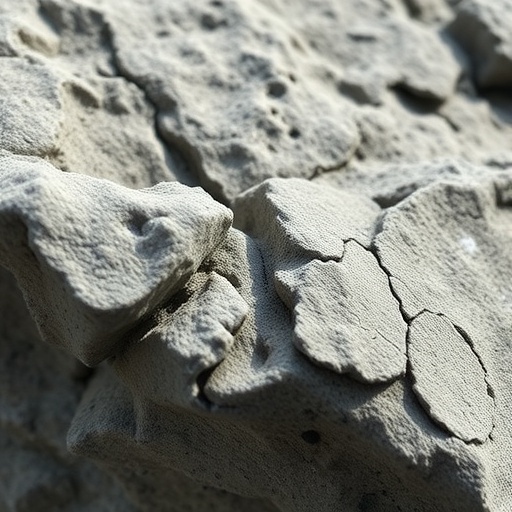In the ever-evolving field of geotechnical engineering and earth sciences, accurate characterization of rock joint surfaces plays a pivotal role in understanding geological stability, predicting rock mass behavior, and ensuring the safety of infrastructure projects. Recently, a groundbreaking methodology has been introduced, revolutionizing how the roughness of rock joints is quantified. This approach integrates advanced deep learning architectures—specifically the SE-Net attention mechanism and convolutional neural networks (CNN)—to precisely determine the Rock Joint Roughness Coefficient (JRC). The study, published in Environmental Earth Sciences, marks a significant leap forward, leveraging artificial intelligence to tackle a long-standing challenge in rock mechanics.
Determining the JRC traditionally involved subjective visual assessments or labor-intensive computations based on profile measurements. These conventional techniques, while valuable, often suffered from inconsistency, operator bias, and limitations in capturing subtle surface details. The introduction of deep learning to this sphere addresses these obstacles by automating and standardizing roughness evaluation with unprecedented accuracy. By capitalizing on algorithms originally developed for image processing and pattern recognition, researchers have created a system that perceives intricate variations and textures in rock joint surfaces, far beyond the capabilities of manual methods.
Central to this innovation is the SE-Net attention module—a neural network component that excels in refining feature representations by adaptively recalibrating channel-wise feature responses. When combined with CNNs, which specialize in extracting spatial hierarchies of features through convolutional layers, the model effectively isolates critical characteristics that define surface roughness. In practical terms, the SE-Net block enhances the network’s sensitivity to relevant descriptors in input images, filtering out redundant information and strengthening feature discrimination. This fusion not only improves prediction accuracy but also bolsters the model’s robustness across varying rock types and imaging conditions.
The researchers curated a comprehensive dataset comprising high-resolution images of diverse rock joint surfaces, each annotated with corresponding JRC values determined by established measurement protocols. Preprocessing steps involved normalizing image scales, adjusting lighting variations, and augmenting the data to reinforce model generalizability. The training procedure included iterative optimization, fine-tuning network parameters to minimize prediction errors and prevent overfitting. The resulting deep learning framework demonstrated remarkable predictive performance, outperforming benchmark models and traditional feature extraction techniques in both mean error metrics and stability across unseen samples.
One notable advantage of this AI-powered methodology is its scalability and efficiency. Manual estimation of JRC is notoriously time-consuming, often requiring experienced geologists and meticulous sample preparation. With the SE-Net enhanced CNN approach, estimates can be generated rapidly from standard photographic inputs, facilitating real-time assessments in the field or during laboratory experiments. This capability holds transformative potential for projects where swift, reliable data inform critical decisions, such as tunneling operations, slope stability analyses, and mining safety evaluations.
Furthermore, the integration of attention mechanisms allows for interpretability—a crucial factor when deploying AI models in scientific contexts. By visualizing the attention maps generated within the network, practitioners can gain insights into which regions of the rock joint image contributed most significantly to the JRC prediction. This transparency bridges the gap between black-box AI models and the domain knowledge of geotechnical engineers, fostering trust and encouraging wider adoption.
This study’s implications extend beyond immediate applications in rock mechanics. The success of SE-Net and CNN architectures in deciphering subtle surface textures emphasizes the broader trend of utilizing cutting-edge AI techniques to decode complex natural patterns. The interdisciplinary approach, marrying computer vision with geological expertise, exemplifies how modern science thrives at the intersection of diverse fields. The method sets a precedent for similar applications—ranging from soil texture analysis to fracture network characterization—where precision and automation are paramount.
Nevertheless, challenges remain to be addressed. Despite its superior accuracy, the model’s performance can vary with extreme environmental conditions or unusual rock morphologies not represented in the training data. Future research will need to explore adaptive learning strategies, domain adaptation, and the incorporation of multimodal data sources such as 3D scans or hyperspectral imaging to further enhance robustness and versatility. Collaborations between AI specialists and field geologists will be instrumental in refining these models for practical deployment.
The scalability of this approach also suggests promising utility for large-scale geological surveys and infrastructure monitoring. Automated JRC mapping across extensive regions could feed into digital twins of geological formations, supporting continuous risk assessment and resource management. This aligns with the growing momentum toward smart cities and infrastructure systems equipped with integrated AI-powered sensing and analytics technologies.
Moreover, the research highlights the importance of data quality and labeling accuracy. The foundation of any supervised learning model lies in trustworthy ground-truth annotations. Therefore, advancing standardized imaging protocols and leveraging community-wide datasets will be crucial to sustaining progress. As more open-source repositories emerge, collective efforts can accelerate model development, benchmarking, and adoption in varied geological contexts.
In conclusion, the innovative method developed by Zhou, Fu, Zhao, and colleagues represents a transformative step forward in quantitatively assessing rock joint roughness. By harnessing the strengths of the SE-Net attention mechanism combined with CNN architectures, the approach delivers precise, interpretable, and efficient JRC determinations. This accomplishment not only elevates the state of rock mechanics research but also underscores the vast potential of artificial intelligence in revolutionizing geoscientific investigations. As computational tools continue to advance, the fusion of AI and earth sciences promises to unlock deeper understanding and enhanced management of our planet’s complex geological systems.
Subject of Research: The research focuses on accurately determining the Rock Joint Roughness Coefficient (JRC) by utilizing advanced deep learning techniques, specifically the SE-Net attention mechanism integrated with convolutional neural networks, to analyze surface roughness from rock joint images.
Article Title: A rock joint roughness coefficient determination method incorporating the SE-Net attention mechanism and CNN.
Article References:
Zhou, M., Fu, H., Zhao, Y. et al. A rock joint roughness coefficient determination method incorporating the SE-Net attention mechanism and CNN. Environmental Earth Sciences, 84, 411 (2025). https://doi.org/10.1007/s12665-025-12414-x
Image Credits: AI Generated




